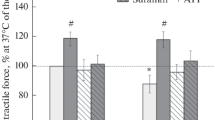Summary
The compound muscle action potential (MAP) and the isometric twitch force of the adductor pollicis of 25 normal subjects were registered after local cooling. Intramuscular temperature ranged from 36.6 to 18.0°C. The amplitude of the MAP increased while the twitch force decreased at lower temperatures. The increase of the MAP could be caused by the effect of cooling directly at the muscle cell membrane. The decreased twitch force probably is due to an effect on the contractile apparatus.
Zusammenfassung
Bei der Myasthenia gravis führt lokale Muskelkühlung zu einer Verbesserung der neuromuskulären Funktion. Über den Einfluß lokaler Kühlung auf die gesunde menschliche Muskelfunktion ist aber wenig bekannt. Bei 25 Personen haben wir vom Adduktor pollicis das Summenaktionspotential (MAP) und die isometrische Zuckungskraft vor und nach Kühlung gemessen. Die intramuskuläre Temperatur erstreckte sich von 36,6 bis 18,0°C. Bei niedrigeren Temperaturen wurde die Amplitude des MAP unerwartet höher, während die Zuckungskraft abnahm. Diese Befunde lassen sich bei Gesunden nicht durch eine Änderung der neuromuskulären Übertragung erklären. Die Vergrößerung der Amplitude des MAP könnte mit einem Temperatureffekt direkt an der Muskelzellmembran zusammenhängen, die erniedrigte Zuckungskraft mit einer Temperatureinwirkung am kontraktilen Apparat.
Similar content being viewed by others
References
Borenstein, S., Desmedt, J. E.: Local cooling in myasthenia. Arch. Neurol. (Chic.) 32, 152–157 (1975)
Boyd, I. A., Martin, A. R.: Spontaneous subtreshold activity at mammalian neuromuscular junctions. J. Physiol. 132, 61–73 (1956)
Buchthal, F., Pinelli, P., Rosenfalck, P.: Action potential parameters in normal human muscle and their physiological determinants. Acta physiol. scand. 32, 219–229 (1954)
Buller, A. J., Ranatunga, K. W., Smith, J. N.: The influence of temperature on the contractil characteristics of mammalian fast and slow twitch skeletal muscle. J. Physiol. 196, 82 P (1968)
Cannard, T. H., Zaimis, E.: The effect of lowered muscle temperature on the action of neuromuscular blocking drugs in man. J. Physiol. 149, 112–119 (1959)
Desmedt, J. E.: The neuromuscular disorder in myasthenia gravis. I. Electrical and mechanical response to nerve stimulation in hand muscles. In: New Developments in Electromyography and Clinical Neurophysiology (J. E. Desmedt, ed.), Vol. 1, pp. 241–304. Basel: Karger 1973
Desmedt, J. E.: Méthodes d'étude de la fonction neuromusculaire chez l'homme. Acta neurol. psychiat. Belg. 58, 977–1077 (1958)
Dudel, J., Rüdel, R.: Temperature dependence of electro-mechanical coupling in crayfish muscle fibers. Pflügers Arch. 301, 16–30 (1968)
Fatt, P., Katz, B.: The electrical properties of crustacean muscle fibres. J. Physiol. 120, 171–204 (1953)
Grob, D.: Spontaneous end-plate activity in normal subjects and patients with myasthenia gravis. In: Myasthenia gravis. Ed. D. Grob. Ann. N.Y. Acad. Sci. 183, 245–269 (1971)
Ludin, H. P., Beyeler, F.: Temperature dependence of normal sensory nerve. J. Neurol. (in press, 1977)
MacLagan, J., Zaimis, E.: The effect of muscle temperature on twitch and tetanus in the cat. J. Physiol. 137, 89–90 P (1957)
Padsha, S. M.: The effect of hypothermia on the isometric twitch and tetanus in the wing muscle of the bat (Eidolon helvum). J. Physiol. 181, 53–54 P (1965)
Ricker, K., Hertel, G., Stodieck, S.: Temperatureinfluß auf die neuromuskuläre Funktions-störgung. In: Myasthenia gravis (G. Hertel, H. G. Mertens, K. Ricker, K. Schimrigk, eds.). Stuttgart: Thieme 1977
Slomić, A., Rosenfalck, A., Buchthal, F.: Electrical and mechanical responses of normal and myasthenic muscle. Brain Research 10, 1–78 (1968)
Truong, X. T., Wall, B. J., Walker, S. M.: Effects of temperature on isometric contraction of rat muscle. Amer. J. Physiol. 207, 393–396 (1964)
Zink, J., Bose, D.: Cold potentiation of neuromuscular transmission in the avian biventer cervicis muscle. Europ. J. Pharmacol. 28, 149–156 (1974)
Author information
Authors and Affiliations
Rights and permissions
About this article
Cite this article
Ricker, K., Hertel, G. & Stodieck, G. Increased voltage of the muscle action potential of normal subjects after local cooling. J. Neurol 216, 33–38 (1977). https://doi.org/10.1007/BF00312813
Received:
Issue Date:
DOI: https://doi.org/10.1007/BF00312813




